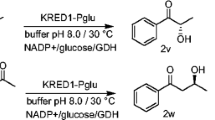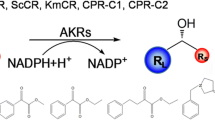Abstract
A novel aldo–keto reductase (LEK) from Lodderomyces elongisporus NRRL YB-4239 (ATCC 11503) was discovered by genome database mining for carbonyl reduction. LEK was overexpressed in Escherichia coli BL21 (DE3), purified to homogeneity and the catalytic properties were studied. Among the substrates, ethyl 4-chloro-3-oxobutanoate was converted to ethyl (R)-4-chloro-3- hydroxybutanoate ((R)-CHBE), an important pharmaceutical intermediate, with an excellent enantiomeric excess (e.e.) (>99 %). The mutants W28A and S209G obtained by site-directed mutation were identified with much higher molar conversion yields and lower Km values. Further, the constructed coenzyme regeneration system with glucose as co-substrate resulted in a yield of 100 %, an enantioselectivity of >99 %, and the calculated production rate of 56.51 mmol/L/H. These results indicated the potential of LEK for the industrial production of (R)-CHBE and other valuable chiral alcohols.




Similar content being viewed by others
References
Nakamura K, Yamanaka R, Matsuda T et al (2003) Recent developments in asymmetric reduction of ketones with biocatalysts. Tetrahedron: Asymmetry 14:2659–2681
Davies SG, Ichihara O (1996) Asymmetric Synthesis of (+)-Negamycin. Tetrahedron: Asymmetry 7:1919–1922
Hikichi S, Hareau GPJ, Sato F (1997) Efficient and practical synthesis of optically active 5-t-butyldimethylsiloxy-2-cyclohexenone as a convenient chiral 2,5-cyclohexadienone synthon. Tetrahedron Lett 38:8299–8302
Miyashita A, Yasuda A, Takaya H et al (1980) Synthesis of 2, 2′-bis(diphenylphosphino)-1, 1′-binaphthyl (BINAP), an atropisomeric chiral bis(triaryl)phosphine, and its use in the rhodium (I)-catalyzed asymmetric hydrogenation of alpha-(acylamino) acrylic acids. J Am Chem Soc 102:7932–7934
Wada M, Kawabata H, Ketaoka M et al (1999) Purification and characterization of an aldehyde reductase from Candida magnoliae. J Mol Catal B: Enzymatic 6:333–339
Kita K, Nakase K, Yanase H et al (1999) Purification and characterization of new aldehyde reductases from Sporobolomyces salmonicolor AKU4429. J Mol Catal B: Enzymatic 6:30–313
Kita K, KATAOKA M, SHIMIZU S (1999) Diversity of 4-chloroacetoacetate ethyl ester-reducing enzymes in yeasts and their application to chiral alcohol synthesis. J Biosci Bioengin 88:591–598
Shimizu S, Kataoka M, Kita K (1998) Chiral alcohol synthesis with yeast carbonyl reductases. J Mol Catal B: Enzymatic 5:321–325
Ni Y, Li CX, Wang LJ et al (2011) Highly stereoselective reduction of prochiral ketones by a bacterial reductase coupled with cofactor regeneration. Organ Biomol Chem 9:5463–5468
Liu X, Chen R, Yang ZW et al (2014) Characterization of a putative stereoselective oxidoreductase from gluconobacter oxydans and its application in producing ethyl (R)-4-chloro-3-hydroxybutanoate ester. Mol Biotechnol 56:285–295
Yin XP, Wei DZ, Yi LN et al (2005) Expression and purification of exendin-4, a GLP-1 receptor agonist, in Escherichia coli. Protein Expr Purif 41(2):259–265
Wang QY, Shen LH, Ye TT et al (2012) Overexpression and characterization of a novel (S)-specific extended short-chain dehydrogenase/reductase from Candida parapsilosis. Bioresour Technol 123:690–694
Zhou LP, Zhao Y, Wang HF et al (2004) Cloning and expression of glucose dehydrogenase from Bacillus Subtilis. J Jiangsu University (medicine edition) 14(1):7–10
Kataoka M, Rohani LP, Yamamoto K et al (1997) Enzymatic production of ethyl (R)-4-chloro-3-hydroxybutanoate: asymmetric reduction of ethyl 4-chloro-3-oxobutanoate by an Escherichia coli transformant expressing the aldehyde reductase gene from yeast. Appl Microbiol Biotechnol 48:699–703
Jez JM, Bennett MJ, Schlegel BP et al (1997) Comparative anatomy of the aldo-keto superfamily. Biochem J 326:625–636
Kataota M, Sakai H, Morikawa T et al (1992) Characterization of aldehyde reductase of Sporobolomyces salmonicolor. Biochim Biophys Acta 1122:57–62
Jing K, Xu Z, Liu Y et al (2005) Efficient production of recombinant aldehyde reductase and its application for asymmetric reduction of ethyl 4-chloro-3-oxobutanoate to ethyl (R)-4-chloro-3-hydroxybutanoate. Prep Biochem Biotechnol 35:203–215
Yang ZH, Yao SJ, Lin DQ (2004) Improving the Stereoselectivity of symmetric Reduction of 3-Oxo Ester to 3-Hydroxy Ester with Pretreatments on Bakers’ Yeast. Ind Eng Chem Res 43(16):4871–4875
Amidjojo M, Weuster-Botz D (2005) Asymmetric synthesis of chiral synthon ethyl-4-chloro-3-hydroxybutanoate using Lactobacillus kefir. Tetrahedron: Asymmetry 16:899–901
Aragozzini F, Valenti M, Santaniello E et al (1992) Biocatalytic, enantioselective preparations of (R)- and (S)-ethyl 4-chloro-3-hydroxybutanoate, a useful Chiral Synthon. Biocatal Biotransfer 5(4):325–332
Acknowledgments
The work was supported by the Technology Research and Development Program of Hangzhou (20130432B05, 20120232B13, and 20130533B17), Zhejiang Provincial Natural Science Foundation of China (LY13C050004, LQ12B06007, and LY13B060008), National Natural Science Foundation of China (21006018, 30900253, and 21206024).
Ethical statement
The experiments comply with the current laws of China in which they were performed.
Author information
Authors and Affiliations
Corresponding authors
Electronic supplementary material
Below is the link to the electronic supplementary material.
Rights and permissions
About this article
Cite this article
Wang, Q., Ye, T., Ma, Z. et al. Characterization and site-directed mutation of a novel aldo–keto reductase from Lodderomyces elongisporus NRRL YB-4239 with high production rate of ethyl (R)-4-chloro-3-hydroxybutanoate. J Ind Microbiol Biotechnol 41, 1609–1616 (2014). https://doi.org/10.1007/s10295-014-1502-8
Received:
Accepted:
Published:
Issue Date:
DOI: https://doi.org/10.1007/s10295-014-1502-8




